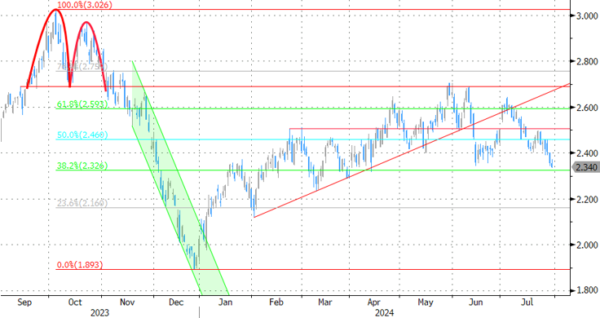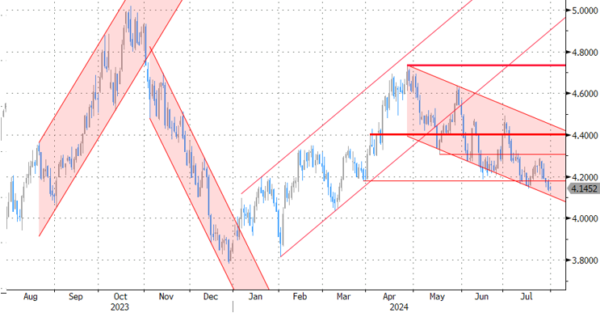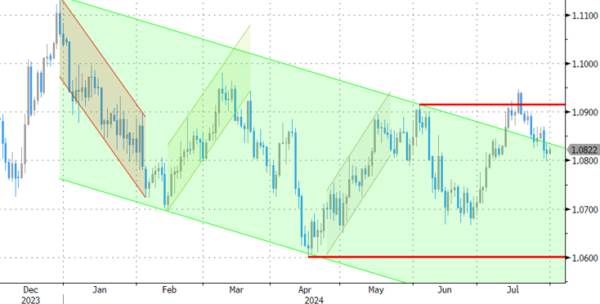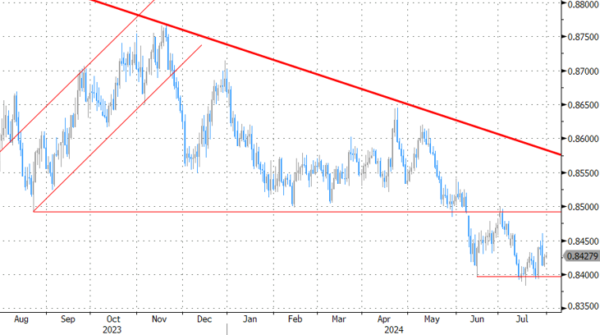Markets
After a series of mixed European GDP and inflation numbers, some US data hit the market yesterday in late afternoon trading too. June JOLTS job openings were at a higher-than-expected 8.18m, down from an upwardly revised 8.23m. Consumer confidence in the Conference Board indicator picked up from 97.8 to 100.3 in July with an improvement in the expectations component offsetting a drop in the assessment of the present situation to the lowest since mid-2021. After some intraday volatility, yields nevertheless ended the day lower. Geopolitical concerns took the upper hand in late US dealings amid reports of Israel having conducted a Hezbollah-aimed retaliatory strike near Lebanon’s capital Beirut. Net daily changes in US yields varied between -2.9 and -4.2 bps. German yields followed by -0.7 and -4.2 bps. Tech sold off again in equity markets, lowering the Nasdaq by some 1.3%. The dollar didn’t take up its safe haven role (e.g. EUR/USD only marginally lower at 1.0815) but the yen did. USD/JPY’s close at 152.77 was the lowest since mid-April. JPY extended gains this morning going into an important BoJ meeting before paring them again (see below). Other market moves take place in Aussie markets (cfr. infra). Asian equity markets shrug off geopolitics by rising up to 3% in China. Both US yields and the dollar trade little changed ahead of some key data, including the ADP job report (expected job growth of 150k) and the Employment Cost Index (+1% in Q2), and the FOMC policy meeting later today. The Fed’s status quo at 5.25-5.5% is widely anticipated. The central question is whether the recent string of beneficial CPI outcomes and mostly below-consensus economic outcomes will prompt clearer clues towards a first cut (in September) in either the statement or the presser. We think there’s a possibility of that to happen, be it subtle in order to prevent the recent sharp yield correction go much further against the background of thinner liquidity circumstances and the risk of a technical acceleration should first support zones in the likes of the US 10-yr break. Complementing the case for (short-term) yields not to drop much lower from current levels is the current pricing in money markets (almost three cuts priced in for 2024). The four cuts for 2025, as things currently stand, seem appropriate as well. First support for the dollar kicks in at EUR/USD 1.09. That should hold.
News & Views
The Australian dollar and swap yields are under pressure this morning. AUD/USD is testing the 0.65 support zone, down from a 0.654 open. Australian swap yields tumble between 11.9 and 19 bps across the curve, the front outperforming. These sharp moves follow the release of Q2 CPI figures. They were bang in line on a headline level, 1% q/q and 3.8% y/y with the latter even quickening from the 3.6% in Q1. Core gauges, though, decelerated more than expected. Advancing 0.8% on a quarterly basis, the yearly prints eased from 4% to 3.9% and 4.4% to 4.1%, depending on the gauge. While still above the Reserve Bank of Australia’s 2-3% target range, the sizeable market moves comes amid speculation the central bank was closer to tightening policy further short term on stubborn inflation rather than easing. It was the RBA itself that as recently as June flagged the possibility of doing so. Today’s data wipe out all such market bets for the upcoming meetings. A rate cut isn’t expected at next week’s though with a full 25 bps move priced in for February 2025 currently.
The Bank of Japan surprised some in the market by raising the policy rate from a range of 0-0.1% to “around” 0.25%. The decision follows as economic activity and prices have been developing generally in line with the BoJ’s outlook, adding that moves to raise wages have been spreading across regions, industries and firm sizes. The hike came against the background of new forecasts, which entailed a minor growth downgrade for the current FY (0.6%) while leaving forecasts for the next two years unchanged at 1%. Core inflation (ex fresh food) was seen lower this FY at 2.5% (from 2.8%) but was tilted to 2.1% for the FY to March 2026 (unchanged at 1.9% for the FY thereafter). The BoJ said that if this outlook materializes, it will further raise the (still accommodative) policy rate. The central bank also announced to taper its monthly bond buying purchases by JPY 400 bn (from JPY 6000 bn now) each calendar quarter with an interim assessment scheduled April 2026. By then, the bank’s balance sheet is seen to have shrunk by about 7-8%. That’s slightly softer than markets expected, which was the buying pace cut in half in tops 1.5 years time. The yen whipsawed on the BoJ outcome before trading back to opening levels of USD/JPY 152.8. Japanese yields to jump an unusually big 2-7 bps across the curve, the front underperforming.
Graphs
GE 10y yield
The ECB cut its key policy rates by 25 bps at the June policy meeting. A more bumpy inflation path in H2 2024, the EMU economy gradually regaining traction and the Fed’s higher for longer US strategy make follow-up moves difficult. Markets are coming to terms with that. Disappointing US and unconvincing EMU data, however, for now brings yields back to their post-French snap election low. The 2.34%-2.4% support zone is being revisited but looks solid.
US 10y yield
The Fed indicated that it needs more evidence to lower its policy rate. June dots suggested one move in 2024 and four next year. Disappointing ISM and back-to-back downward CPI surprises put the US money market back on more than two rate cuts this year (September/December). The US 10-yr yield tests the recent lows and the downside of the downward trend channel in the 4.2% area.
EUR/USD
EUR/USD tested the topside of the 1.06-1.09 range as the dollar lost interest rate support at stealth pace. Markets consider a September rate cut a done deal and only need confirmation from high-ranked Fed officials. In the meantime, the euro got rid of the (French) political risk premium. EUR/USD recently evolved back to a more neutral positioning but is holding up rather well despite ongoing poor EMU data.
EUR/GBP
Debate at the BoE is focused at the timing of rate cuts. May & June headline inflation returned to 2%, but core measures do not align a sustainable return to target soon. Some BoE members at the June meeting nevertheless appeared moving closer to a rate cut. Labour revealed a near £22bn of unfunded commitments, setting the stage for a painful Budget release on October 30. EUR/GBP 0.84 support is being tested.


















